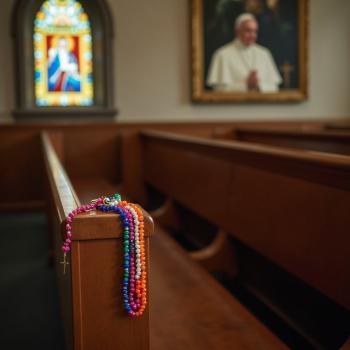When your parish choir has six people, and that number can on any given week dwindle to three, or two, or one, and furthermore, none of you really has a pyrotechnical kind of voice, it’s good to have something simple-yet-effective to whip out of the ol’ binder of a Sunday. We’ve been working at expanding our chant repertoire, because although it goes up and down a lot, chant is a music which simple, untrained voices can sing well. It also requires no accompaniment.
Yesterday one of my choir friends sent me a link for this downloadable chant resource.
Last winter we bought their Catholic Choirbook, which is an excellent resource, especially for a small, self-led choir. So far, we’ve essayed the easier pieces: hymn settings like “Drop, Drop, Slow Tears” for Holy Week, and the Dubois setting of “Adoramus Te, Christe,” which we’ve done with three treble voices singing the soprano, alto, and tenor lines. Kind of a different effect from the full-choir sound; you go with what God gives you to work with, even if all it is is yourself.
The nice thing about much of this music is that you can pull it off under widely varying circumstances. It works here —
as well as it works, oh, here, for instance (a postcard from The Anchoress, by the way. Tomb of St. Philip Neri. Used by permission):
In fact, when you don’t have venerable architecture to remind you of all the people who have knelt where you’re kneeling, and who also longed to go where you long to go, if only you can keep your mind trained in that direction, music can provide an unseen architecture, I always think. It forms an imaginative edifice which reminds you, the singer, and hopefully you the person in the pew as well, that you are part of something which reaches back as well as forward, touches you as it touched the ears of people great and small, gathered in the cold echoing nave of the 14th century, or the 17th, or the 20th. As it will touch, God willing, the ears of your grandchildren.
As an Anglican chorister at the far end of the stalls, in this beautiful, cold 14th-century church, I used to think these kinds of thoughts every week. Of course, in retrospect, I realize that there’s a certain irony in contemplating continuity in a church whose own history has been a tug-o-war, as the whitewashed walls, the clear glass in the windows, and the empty niches in the outside walls bear witness.
At my feet, beneath a carven slab, lay a woman who had died sometime in the seventeenth century, in the midst of the worst of the tug-o-wars, and over the years she became a silent friend to me. All ironies aside, my friend in her repose always served to remind me, Sunday after Sunday, that as she is, so will I be, and that the place where we prayed was a ship bearing us together to that shore.
I lay my conversion to Catholicism at the feet of this prayer, the Choristers’ Prayer, which we prayed every Sunday outside the door of that church before processing into Mass:
Bless, O, Lord, us Thy servants, who gather in Thy temple. Grant that what we sing with our lips, we may believe in our hearts, and that what we believe in our hearts, we may show forth in our lives. Through Christ our Lord, Amen.
Be careful what you pray, especially if what you’re going to sing with your lips is something like this which, albeit in a language which for most of us is like seeing in a glass darkly, spells out the truth the heart cries to receive.
Mine did, at least, and here we are, striving away at it. That first church is my current parish, incidentally, lest you think we’ve got some hyper-rareified aesthetic thing going on here. As you can see, we’re pretty darn ordinary to the naked eye. But when we sing, imperfectly as we sing, we feel our way towards building invisible spires.

















